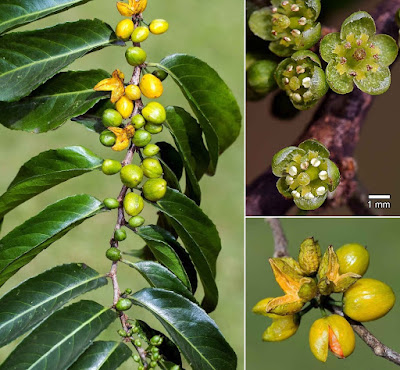 |
| Casearia austroafricana A.E.van Wyk, R.G.C.Boon & Retief
in van Wyk, Boon & Retief, 2018.
Photographs: R.G.C. Boon.
|
Abstract
Casearia austroafricana, a new species from South Africa, is described, illustrated, mapped, and compared with the two other currently accepted southern African members of the genus, namely C. gladiiformis and C. battiscombei. The new species belongs to Casearia sect. Casearia, and is confined to the provinces of KwaZulu-Natal and Eastern Cape. Known for over 100 years by botanists, material of this species has initially been assigned to C. junodii, but from about the 1960s to C. gladiiformis, for which the former is considered a synonym. Casearia austroafricana is readily distinguished by being a tall (up to ca. 30 m) subcanopy or canopy tree associated with temperate or subtropical forest, and in having twigs of young growth usually markedly zigzag, leaves of mature growth with blade relatively thin, principal lateral veins usually 8–10 pairs, margin distinctly serrate-crenate, flowers with the ovary glabrous, and capsules with relatively few seeds (3 or 4). A conservation assessment of “Least Concern” is recommended for this species based on IUCN Red List categories and criteria. Ecological associates are mentioned, including epiphytic ferns, orchids, birds attracted by the arillate seeds, and Lepidoptera (moths) for which it serves as host-plant.
Keywords: Afromontane Forest, Casearia sect. Casearia, Eastern Cape, epiphytes, KwaZulu-Natal, Lepidoptera, Maputaland Centre of Endemism, Maputaland-Pondoland-Albany Hotspot, Pondoland Centre of Endemism, Samydaceae, Scarp Forest, taxonomy, trees, Eudicots
Casearia austroafricana A.E.van Wyk, R.G.C.Boon & Retief, sp. nov.
Casearia austroafricana resembles C. gladiiformis, but is easily distinguished from this species by, amongst others, growing under temperate or subtropical conditions, always in or near forest (vs. tropical, and in either open woodland, thicket or forest), with the trees becoming taller (>20 m vs. <10 m), in having young twigs usually markedly zigzag (vs. straight or weakly zigzag), leaves of mature growth with blade relatively thin (firmly chartaceous vs. coriaceous), margin glandular-serrate (vs. entire), ovary glabrous (vs. hirsute, at least towards the apex), and fewer seeds per capsule (3 or 4 vs. ca. 10)
....
Etymology:—The specific epithet is the Latin for “South Africa”, chosen because the new species is the only member of Casearia endemic to the country.
Common names:— Existing names include swordleaf, southern swordleaf, suidelike bosswaardblaar (Afrikaans), smozob (Zulu?; from Henkel s.n.) and qokama (Xhosa; from Acocks 12820).
Abraham E. van Wyk, Richard G.C. Boon and Elizabeth Retief. 2018. A New Species of Casearia (Samydoideae, Salicaceae) from South Africa. Phytotaxa. 383(3); 273–282. DOI: 10.11646/phytotaxa.383.3.4


